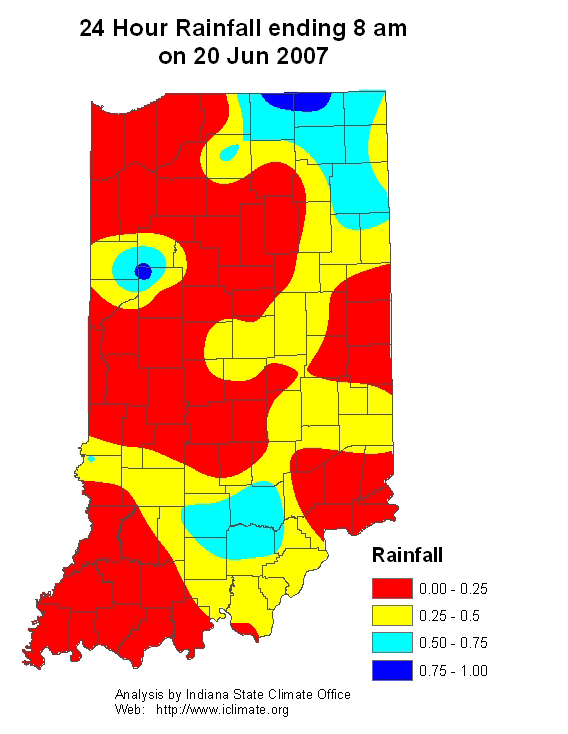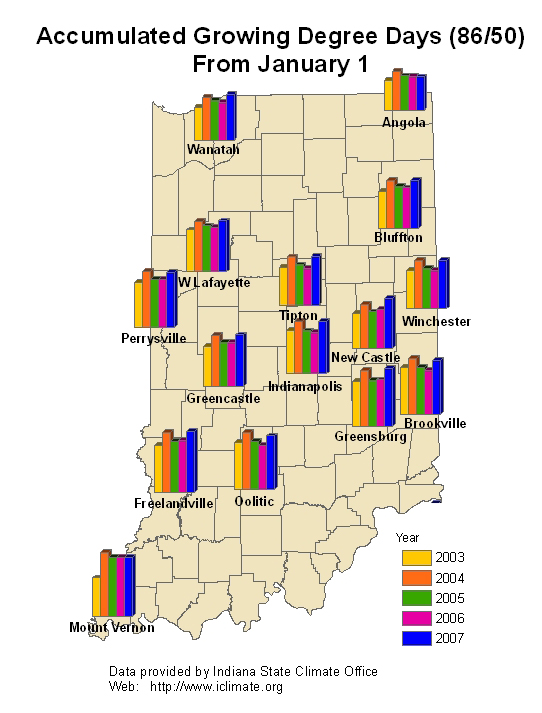Pest & Crop Newsletter
![]()
Rootworms Feeding, Adults Beginning to Emerge - (Christian Krupke, John Obermeyer, and Larry Bledsoe)
- Rootworms are surviving the dry conditions, feeding damage exacerbated by lack of root regrowth.
- Beetles are beginning to emerge, well ahead of normal emergence period.
- High-risk fields should be evaluated now for rootworms and root damage.
- Rescue treatment guidelines are given below.
Rootworm larvae have been hatching and seeking corn roots for several weeks. Immediately after hatching, the very small larvae crawl through the soil until finding corn roots. This is when the newly hatched larvae are most vulnerable to either desiccation or drowning if soils are extremely dry or wet. Once contact is made with the root, the larvae immediately begin feeding and enter the root. As they increase in size, so does their damage. They will feed both inside and outside the roots, causing tunneling and root pruning.
Several have asked if the rootworm mortality would be high this year because of the dry soils. From initial evaluations of our rootworm plots and reports we have seen, it is obvious that rootworm larvae have been successfully finding roots. In addition, the damage may be greater than normal because any root regrowth will be inhibited by hot and dry soils. This forces the larvae to feed more extensively on the “juicy” nodal roots, which are critical to keep the plant upright during pollination and ear fill.
Rootworm development has been progressing rapidly with the warm soils, as beetles are beginning to emerge throughout the state. One lonely male beetle was found in Carroll County on June 18, about a week earlier than normal. Many pupae have been found during root digs. However, this just represents the “tip of the iceberg” - because rootworm hatching and feeding extends over several weeks, there is still time to sample roots of plants in high-risk fields, especially where insecticide efficacy is in question.
To sample for rootworms, use a shovel and lift out the root mass and surrounding soil and place on a dark surface (black plastic garbage bags work well). Carefully break up the clods and sort through the soil. Look for 1/4 to 1/2 inch long, slender, creamy-white larvae with brownish-black heads and “tails.” Once the soil has been separated from the root mass, inspect it for root scarring and pruning. You may find the larvae under the leaf collars that are close to nodal roots; tear these leaves away to check. You may also observe the rootworms sticking out of roots. Repeat this process with several plants representing different areas of a field. An average of two or more larvae per plant represents a rootworm population that signals the need for a rescue cultivation application.
Insecticides applied after planting should be directed toward the base of plants. It is also important to throw soil up around plants to incorporate the insecticide and promote the establishment of brace roots. A good brace root system will help prevent plant lodging and reduce losses due to rootworm feeding. If a no-till field has an economic population of larvae, placing the insecticide on top of the ground will normally not be effective. The only exceptions might be if the soil insecticide is watered in through irrigation or rainfall (ideally a half inch or more). Two liquid soil insecticides, Furadan 4F and Lorsban 4E, are labeled for post-directed applications. If one decides to mix the insecticide with a liquid nitrogen source for a sidedress application, compatibility checks should be made. Broadcasting the insecticide will greatly diminish rootworm efficacy.
 VIDEO: Watch a short video of rootworms feeding on corn roots. Note their brown heads and black tail plate.
VIDEO: Watch a short video of rootworms feeding on corn roots. Note their brown heads and black tail plate.
![]()
Soybean Aphid Look-Alikes - (Christian Krupke, John Obermeyer and Larry Bledsoe)
Correct identification of a pest is the first necessary step in Integrated Pest Management. The heightened interest in soybean aphid has many pest managers carefully observing backsides of leaves for this plant sucker. Some are surprised and unprepared to find the plethora of insects occupying this zone, leading to frequent misidentification of soybean aphid. The following magnified images highlight some common critters often seen with or without soybean aphid. The use of at least a 10X magnifier is necessary to correctly see and identify these arthropods. Size and color are NOT reliable identifying characteristics; most of the following arthropods will readily move about the leaf surface but soybean aphid moves very slowly if at all. Look for the black cornicles, or “tailpipes” on a soft-bodied green-yellow insect to confirm identifications.
Soybean Aphid:

Soybean aphid colonizing new growth

Note the cornicles, "tailpipes" on the rear and antennae on the head of soybean aphid
Potato leafhopper:

Early potato leafhopper nymph and soybean aphid
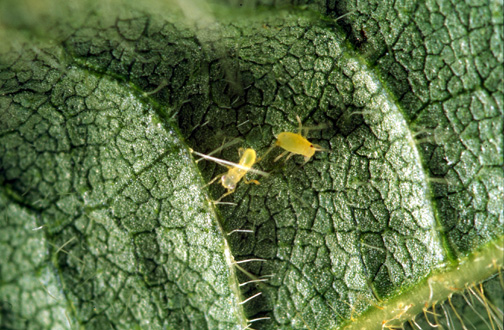
Nymphs of potato leafhopper
Twospotted spider mite:
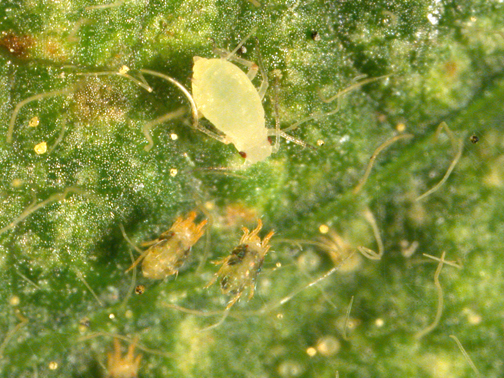
Soybean aphid and spider mites
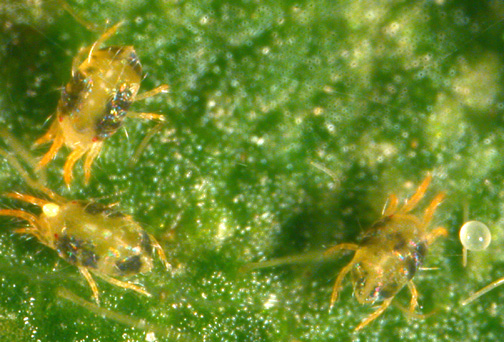
Microscopic picture of spider mites with egg
Thrips:

Soybean thrips adult and nymphs
Mealybug:
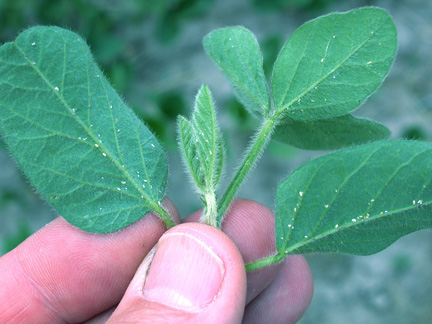
Mealybugs on new trifoliolate leaf

Close-up of mealybugs on leaf
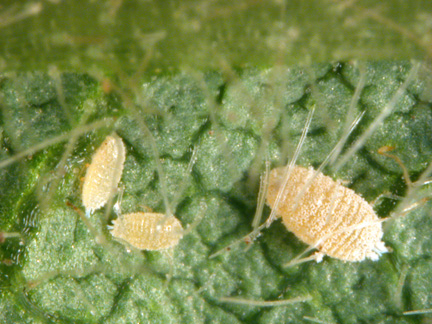
Microscopic picture of mealybugs
Pirate bug (predator of aphids):

Good guy: Pirate bug adult feeding on a soybean aphid
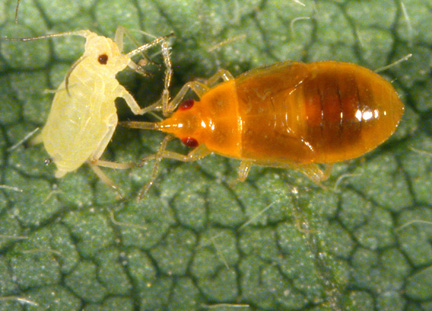
Good guy: Pirate bug nymph feeding on a soybean aphid
![]()
Click here to view the
Black Light Trap Catch Report - (John Obermeyer)

Ear Size Determination in Corn - (Bob Nielsen)
- Ear shoots are initiated at multiple stalk nodes very early in a corn plant’s development.
- Ear size determination of the uppermost (harvestable) ear begins by the time a corn plant has reached knee-high and finishes 10 to 14 days prior to silk emergence.
The number of harvestable kernels per ear is an important contributor to the grain yield potential of a corn plant. Severe plant stress during ear formation may limit the potential ear size, and thus grain yield potential, before pollination has even occurred. Optimum growing conditions set the stage for maximum ear size potential and exceptional grain yields at harvest time. The size of what will become the harvestable ear begins by the time a corn plant has reached knee-high and finishes 10 to 14 days prior to silk emergence.
Ear Shoot Development
An axillary meristem forms at each stalk node (behind the leaf sheath) beginning at the base of the stalk and continuing toward the top (acropetally for you wordsmith fans) except for the upper six to eight nodes of the plant. Each axillary meristem initiates husk leaves at the nodes of the ear shank and eventually an ear itself at the distal tip of the ear shank.
By about the V5 or V6 stages of development (five to six visible leaf collars), the growing point (apical meristem) of the corn plant finishes the task of initiating leaf primordia and completes its developmental responsibilities by initiating the tassel primordium of the plant. At about the same time that the tassel is initiated, the uppermost harvestable (and final) ear is also initiated (Lejeune and Bernier, 1996). This uppermost ear is normally located at the 12th to 14th stalk node, corresponding to the 12th to 14th leaf of the plant.
Careful removal of the leaves from a stalk, including leaf sheaths, at about growth stage V10 (ten visible leaf collars) will usually reveal 8 to 10 identifiable ear shoots. Each ear shoot originates at a stalk node, behind its respective leaf sheath. At growth stage V10, these tiny ear shoots primarily consist of husk leaf tissue. The developing ears themselves are only a fraction of an inch in length.
Initially, the ear shoots found at the lower stalk nodes are longer than the ones at the upper stalk nodes simply because the lower ones were created earlier. As time marches on, the upper one or two ear shoots assume priority over all the lower ones and ultimately become the harvestable ears. Development of the upper ears is favored over the lower ones partly because of hormonal “checks and balances” and partly because of the proximity of the upper ear to the actively photosynthesizing leaves of the upper canopy.
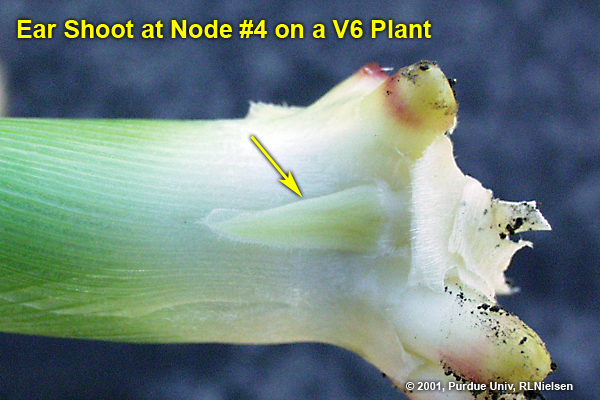

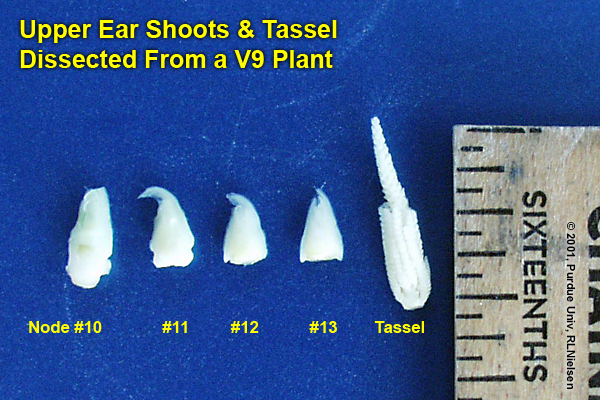
Ear Size Determination
Row number and kernel number per row are two of several yield components in corn. Typically, from 750 to 1000 ovules (potential kernels) develop on each ear shoot. The number of kernel rows multiplied by the number of kernels per row determines total kernel number per ear. Actual (harvestable) kernel number per ear averages between 400 and 600. For a 16-row ear, one kernel per row is equal to about five bushels per acre (for average populations).
Like so many other processes in the corn plant, kernel row number determination on an ear proceeds in an acropetal fashion (from base to tip). Kernel row number determination of the uppermost ear begins shortly after the ear shoot is initiated (V5 to V6) and is thought to be complete as early as V8 (Strachan, 2004).
Kernel rows first initiate as “ridges” of cells that eventually differentiate into pairs of rows. Thus, row number on ears of corn is always even unless some sort of stress disrupts the developmental process. True row number is often difficult to visualize in tiny ears dissected from plants younger than about the 12-leaf stage.
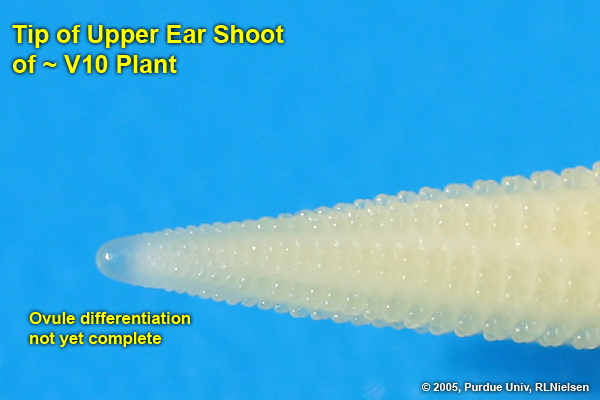

Row number is determined strongly by plant genetics and less so by environment. This means that row number for any given hybrid will be quite similar from year to year, regardless of growing conditions. Some exceptions to this include the effects of injury from the post-emergence application of certain sulfonylurea herbicides or nearly complete defoliation by hail damage prior to growth stage V8.
The potential number of kernels per row is complete by at least V15 and maybe as early as V12 (Strachan, 2004). Kernel number (ear length) is strongly affected by environmental stresses. This means that potential ear length will vary dramatically from year to year as growing conditions vary. Severe stress can greatly reduce potential kernel number per row. Conversely, excellent growing conditions can encourage unusually high potential kernel number.
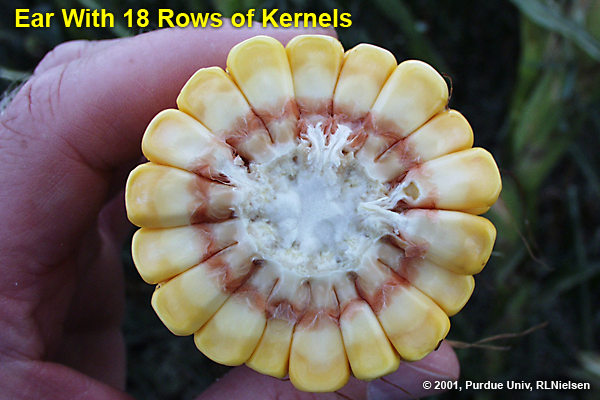
Final Comments
Because ear initiation does not occur until about V5, stress prior to this leaf stage has no direct bearing on ear size determination UNLESS that stress eventually results in a severely stunted or weakened plant. This is particularly true for stress events that damage only the above ground portion of young seedlings without damage to the plants’ growing point regions. Such damaged plants usually can recover well with little evidence of the damage some weeks down the road.
Severe stress from about V5 to V12 that severely limits photosynthesis can directly interfere with ear size determination and result in fewer kernel rows (less likely) or fewer kernels per row (more likely). While such early stress can be important, recognize that severe stress that occurs shortly before to shortly after pollination has a far greater potential to reduce yield per day of stress.
Related References
Bonnett, O.T. 1966. Inflorescences of Maize, Wheat, Rye, Barley, and Oats: Their Initiation and Development. Bulletin 721. Univ. of Illinois, College of Ag., Agricultural Expt. Sta.
Lejeune, P. and G. Bernier. 1996. Effect of environment on the early steps of ear initiation in maze (Zea mays L.) Plant, Cell and Environment, 19:217-224.
Ritchie, S.W., J.J. Hanway, and G.O. Benson. 1992. How a Corn Plant Develops (SP-48). Iowa State Univ. [On-Line]. Available at <http://www.extension.iastate.edu/pages/hancock/agriculture/corn/
corn_develop/CornPlantStages.html>. (URL verified 6/16/07).
Strachan, Stephen D. 2004. Corn Grain Yield in Relation to Stress During Ear Development. Pioneer, a DuPont Company. [On-Line]. Available at <http://www.pioneer.com/growingpoint/agronomy/library_corn/ear_development.jsp> [URL verified 6/16/07. Note that access to this article requires registration (free) to Pioneer’s Growing Point Web site.
For other Corny News Network articles, browse through the CNN Archives at <http://www.kingcorn.org/news/archive.html>. For other information about corn, take a look at the Corn Growers’ Guidebook at <http://www.kingcorn.org>.
